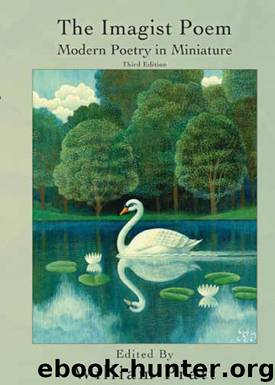The Imagist Poem by William Pratt

Author:William Pratt [Pratt, William]
Language: eng
Format: epub
ISBN: 978-0-9728143-8-6
Publisher: Uno Press
Published: 2012-03-10T17:30:09+00:00
William Pratt
Oxford, Ohio
Notes
1 T.S. Eliot, “American Literature and the American Language,” To Criticize the Critic, by Eliot (New York: Farrar, Straus & Giroux, 1965) 58.
2 T.E. Hulme, “Romanticism and Classicism,” Speculations, ed. Herbert Read (New York: Harcourt, Brace, 1924) 121–22.
3 René Taupin, The Influence of French Symbolism on Modern American Poetry, trans. William Pratt and Anne Rich Pratt (New York: AMS, 1985) 116.
4 Actually, although the article was signed by Flint, much of it was paraphrased directly from an interview with Pound. See Christopher Middleton, “Documents on Imagism from the Papers of F.S. Flint,” The Review 15 (Apr. 1965): 35–51.
5 A more detailed account of these meetings may be found in an article by A.R. Jones, biographer of Hulme. See “Notes Toward a History of Imagism,” South Atlantic Quarterly LX (Summer 1961): 262–85.
6 See H.D.’s account in End to Torment: A Memoir of Ezra Pound (New York: New Directions, 1979) 18.
7 Hulme, “A Lecture on Modern Poetry,” Further Speculations, ed. Sam Hynes (Minneapolis: U of Minnesota P, 1955) 68.
8 Hulme, “Notes on Language and Style,” Further Speculations 81.
9 Hulme, “Notes on Bergson,” Further Speculations 60.
10 Hulme, “Lecture on Modern Poetry,” Further Speculations 74.
11 Herbert Read, “Ezra Pound,” The Tenth Muse, by Read (London: Routledge & Kegan Paul, 1957) 264–65.
12 Hulme, “Notes on Language and Style,” Further Speculations 84.
13 Hulme, “Romanticism and Classicism,” Speculations 134–35.
14 Ezra Pound, “Vorticism,” Fortnightly Review ns XCVI (Sept. 1, 1914): 469.
15 Pound, “Vorticism,” Fortnightly Review 465–67.
16 Taupin 96.
17 Taupin 93.
18 This quotation, first published in Poetry and Drama in 1912, is included in “A Retrospect,” a collection of Pound’s various writings on Imagism, published in Pavannes and Divisions (1918), and later in The Literary Essays of Ezra Pound, ed. T.S. Eliot (New York: New Directions, 1954) 3–14.
19 Pound, “Vorticism,” Fortnightly Review 3.
20 Pound, “A Retrospect,” Literary Essays of Ezra Pound 3.
21 Still largely true of American critics, in spite of two full-sized books on the Imagist movement: Glenn Hughes’ Imagism and the Imagists, published by Stanford University Press in 1931, and Stanley Coffman’s Imagism: A Chapter for the History of Modern Poetry, published by the University of Oklahoma Press in 1951. British critics, however, have paid more serious attention to Imagism, with some, like Frank Kermode, in Romantic Image (London: Routledge & Kegan Paul, 1957) and Graham Hough, in Reflections on a Literary Revolution (Washington: Catholic UP, 1960) using it as a means of disparaging modern poetry. But others, especially Herbert Read in The Tenth Muse, and even more, Stephen Spender in The Struggle of the Modern (Berkeley: U of California P, 1963) have seen it as essential to the development of modern poetic style. Whatever their point of view, both American and British critics have acknowledged the fundamental importance of Imagism to modern poetry in English.
22 Stevens, “Adagia,” Opus Posthumous, ed. Samuel F. Morse (New York: Knopf, 1957) 161.
23 Stevens, “Rubbings of Reality,” Opus Posthumous 258.
24 William Carlos Williams, Selected Letters (New York: McDowell, Obolensky, 1957) 126.
25 R.P. Blackmur, “Lord Tennyson’s Scissors: 1912–50,” Form and Value in Modern Poetry, by Blackmur (New York: Doubleday Anchor, 1957) 374.
Download
This site does not store any files on its server. We only index and link to content provided by other sites. Please contact the content providers to delete copyright contents if any and email us, we'll remove relevant links or contents immediately.
4 3 2 1: A Novel by Paul Auster(11098)
The handmaid's tale by Margaret Atwood(6894)
Giovanni's Room by James Baldwin(5928)
Big Magic: Creative Living Beyond Fear by Elizabeth Gilbert(4759)
Asking the Right Questions: A Guide to Critical Thinking by M. Neil Browne & Stuart M. Keeley(4621)
On Writing A Memoir of the Craft by Stephen King(4245)
Ego Is the Enemy by Ryan Holiday(4019)
Ken Follett - World without end by Ken Follett(3991)
The Body: A Guide for Occupants by Bill Bryson(3855)
Bluets by Maggie Nelson(3740)
Adulting by Kelly Williams Brown(3702)
Guilty Pleasures by Laurell K Hamilton(3613)
Eat That Frog! by Brian Tracy(3547)
White Noise - A Novel by Don DeLillo(3453)
The Poetry of Pablo Neruda by Pablo Neruda(3386)
Alive: The Story of the Andes Survivors by Piers Paul Read(3333)
The Book of Joy by Dalai Lama(3257)
The Bookshop by Penelope Fitzgerald(3246)
Fingerprints of the Gods by Graham Hancock(3238)
